2 How Drugs Work in the Body and the Brain
Introduction
Drugs are chemical substances that when taken into the body can have great impacts on the brain and the body systems. Knowing how the brain works, and the impacts that drugs can have on brain function and behavior, will give you the knowledge and power to make decisions about your own drug use.
Learning Objectives
- Know what glia, neurons and neurotransmitters do in the brain
- Describe how psychoactive drugs affect the brain when they interact with neurons
- Understand how drugs work in the brain and body
- Understand drug impacts on various body systems
- Describe and understand the Biomedical and Biopsychosocial models
Learning Content
What happens to your brain and body when you take drugs? Taking drugs impacts the brain. Taking drugs impacts homeostasis (steadiness between the different elements) between the glia cells and neurons in the brain.
Glia cells maintain homeostasis and provide protection and support for neurons in the central nervous system and the peripheral nervous systems.
The main functions of glia are to hold neurons in place by surrounding them, supply oxygen and nutrients to neurons, insulate one neuron from another, remove dead neurons and destroy pathogens, and help with synaptic connections and physiological processes (Brodal, 2010).
Neurons are cells that communicate with other cells via synapse connections. There are three types of neurons:
- Sensory neurons respond to stimuli by sensing signals sent to the brain and spinal cord
- Motor neurons receive signals from the brain and spinal cord
- Interneurons connect neurons that are in the same region in the brain and spinal cord
Image 2.1 – Neuron Cell Diagram
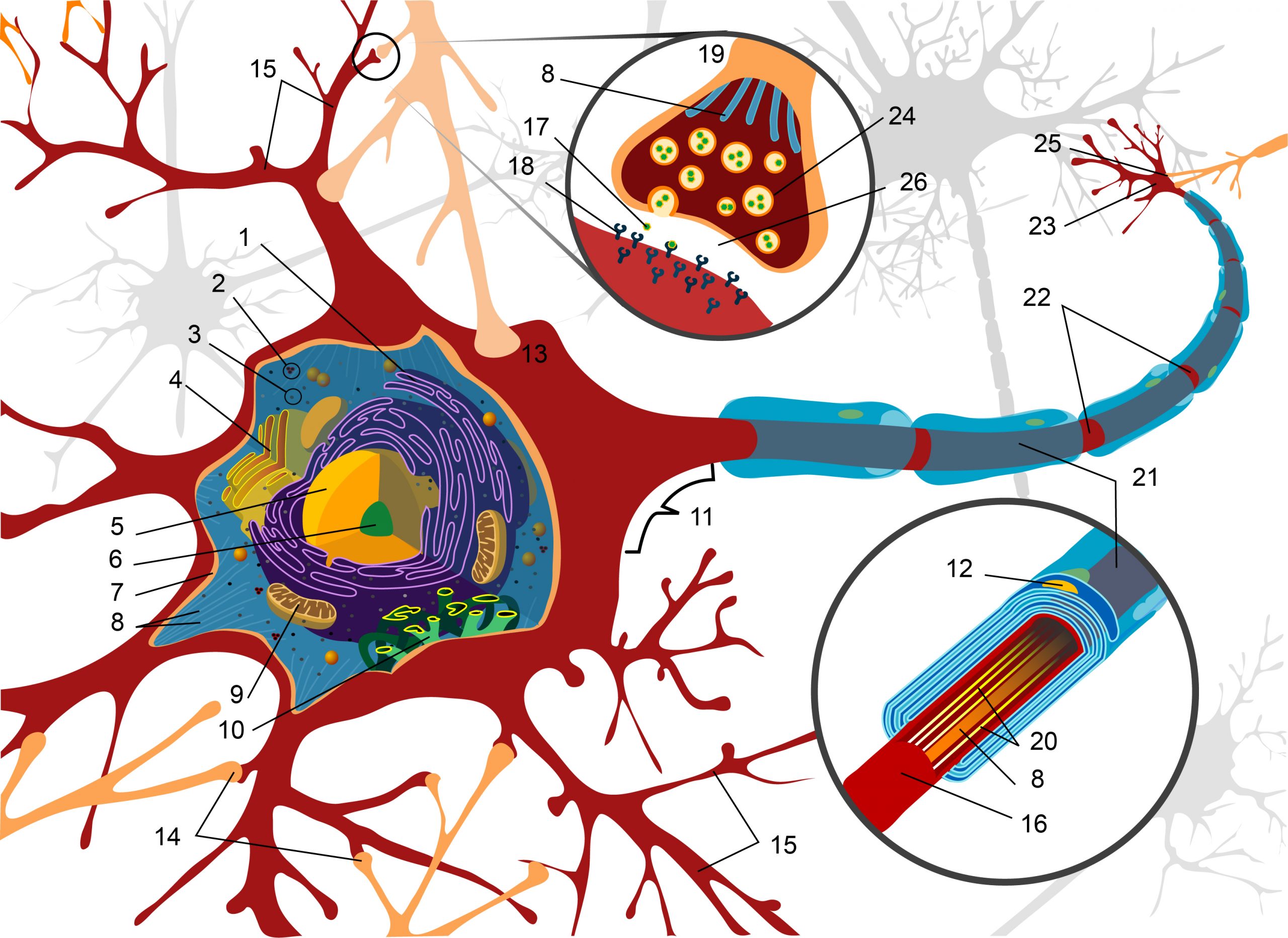
Synapses permit nerve cells to pass electrical or chemical signals to another neuron.
Image 2.2 – Chemical Synapse Schema
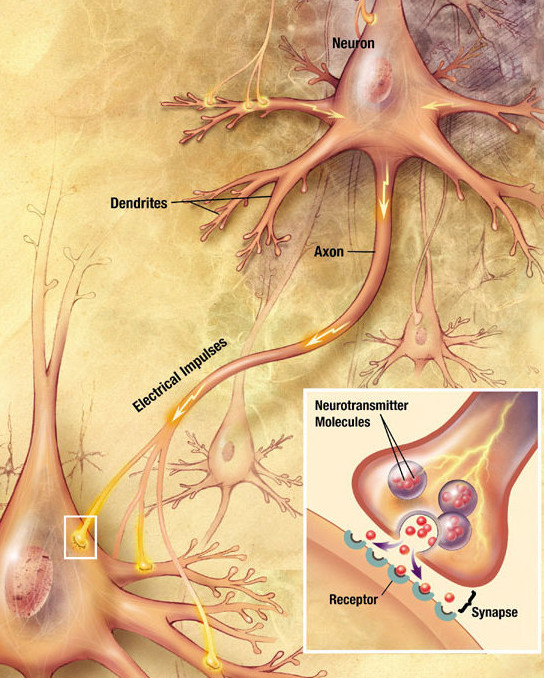
Neurotransmitters are chemical messengers that transmit messages across a synapse.
Image 2.3 – Neuron Synapse During Neurotransmitter Re-Uptake
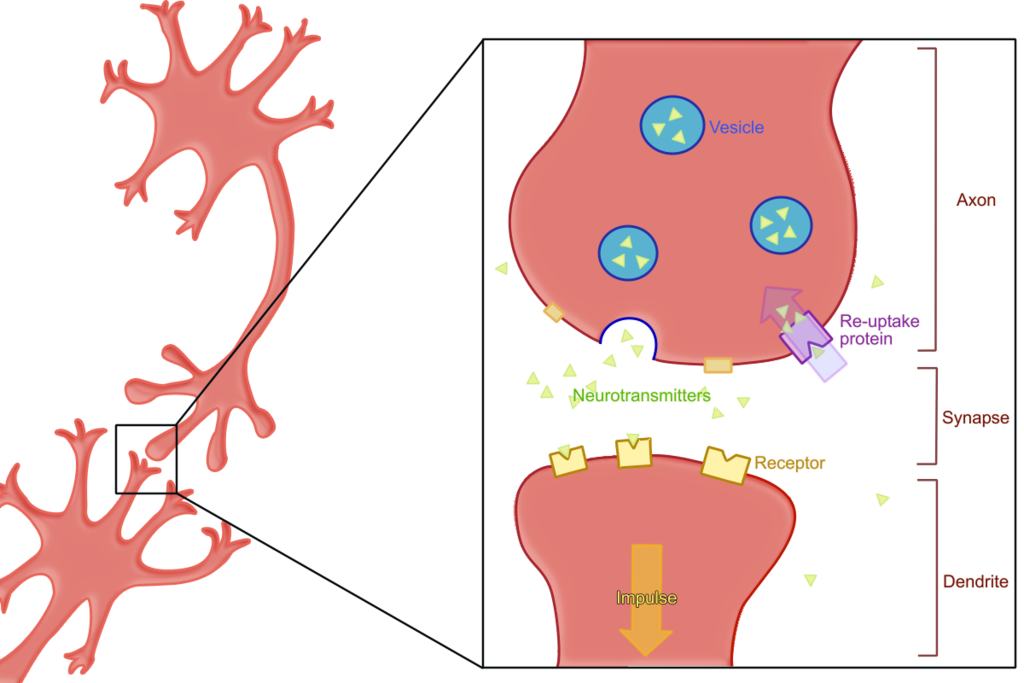
Psychoactive drugs alter brain functions and act on the brain by altering the neurotransmitter availability at the synapse or by interacting with the neurotransmitter receptor itself. These types of drugs alter chemical levels in the brain which impact mood and behavior, which is what the neurotransmitters try to help manage.
Check Your Knowledge
Drug Effects on the Brain and Body
Watch this short video on how drugs affect the brain:
Video 2.1 – How Do Drugs affect the Brain
Many drugs are made of chemicals that are similar to chemicals that already exist in the brain. Drugs alter the way messages from nerve cells are sent, received and processed in the brain. Drugs alter the messaging in the brain in these four ways; the natural chemical messengers are imitated by the drug, the reward circuit of the brain is overstimulated by the drug, the drug floods the brain and it becomes overwhelmed by the chemical in the drug, or the drug binds to the brain receptors and alters the brain’s function.
Heroin and marijuana tend to fool the brain’s receptors and activate abnormal messages that are sent by nerve cells. These messages cause a “high” that you feel when you take the drug.
Methamphetamine and cocaine cause nerve cells to release large amounts of neurotransmitters that cause signals from neurons to not shut off, causing an amplified effect in the brain. Again, a high occurs; it is just a different type of high.
All drugs indirectly or directly affect the reward system in the brain. The overstimulation in the system produces a euphoric effect that occurs in response to the drug. The euphoric effect can mimic something that the brain thinks is normal and needed, like eating or feeling the love of someone that cares for you. The brain’s response can compel some people to seek that drug again and more often because the reward system desires the effect (NIDA Drugs, brains, and behavior: The science of addiction preface, 2021).
Image 2.4 – Brain’s Pleasure Center
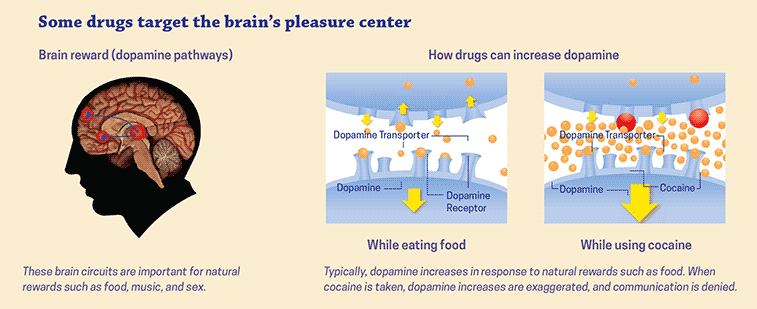
This video on addiction can help you better understand how overuse of a drug can lead to the need to continue using the drug.
Video 2.2 – The Chemistry of Addiction
Check Your Knowledge
Biomedical Model
Ill health is caused by biological factors that are linked to lifestyle choices and the best course of treatment and recovery of the patient is the main concern.
Video 2.3 – Biomedical Versus Biopyschosocial Models of Healthcare
Biopsychosocial Model
Image 2.5 – Biosychosocial Model of Health
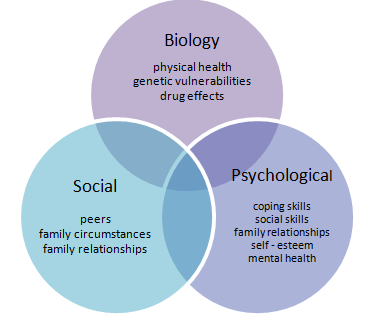
To understand a person’s medical condition you need to understand the connections between biology, psychology, and the environment in which the person lives. All three of these factors impact the human body in different ways.
Video 2.4 – The Biopyschosocial Model
It is important to consider all aspects of health and mind when looking at the impact drugs can have on the brain and body. Think about the risk of addiction for you, the people you care about and your community. What will you do to minimize these risks for yourself and others?
Supplemental Resources
National Alliance of Mental Health. (n.d.). Home [Homepage]. https://www.nami.org/Home
National Conference of State Legislatures. (2018, February 23). Pharmaceuticals. https://www.ncsl.org/research/health/pharmaceuticals-facts-policies-and-ncsl-resources.aspx
National Institute of Drug Abuse. (2017, March 9). Impacts of drugs on neurotransmission [Archived webpage]. U.S. Department of Health and Human Services, National Institutes of Health, Retrieved September 6, 2021 from https://archives.drugabuse.gov/news-events/nida-notes/2017/03/impacts-drugs-neurotransmission
National Institute on Drug Abuse. (2018, June 6). Understanding drug use and addiction drug facts. U.S. Department of Health and Human Services, National Institutes of Health. Retrieved July 6, 2021, from https://nida.nih.gov/publications/drugfacts/understanding-drug-use-addiction
National Institute of Drug Abuse. (2020, July). Drugs, brains, and behavior: The science of addiction preface. U.S. Department of Health and Human Services, National Institutes of Health. Retrieved July 16, 2021, from https://nida.nih.gov/publications/drugs-brains-behavior-science-addiction/preface
National Institute of Drug Abuse. (2021, March 11). Opioid overdose crisis. U.S. Department of Health and Human Services, National Institutes of Health. https://nida.nih.gov/drug-topics/opioids/opioid-overdose-crisis
The University of Queensland. (n. d.). Websites and apps – Neuroscience [LibGuide]. https://guides.library.uq.edu.au/neuroscience
Watkins, M. (2021). How drugs affect the brain and central nervous system. American Addiction Centers. Retrieved July 6, 2021, from https://americanaddictioncenters.org/health-complications-addiction/central-nervous-system
References
Brodal, P. (2010). The central nervous system: Structure and function (4th ed.). Oxford University Press.
Green, H. [SciShow]. (2012, November 18). The chemistry of addiction [Video]. YouTube. https://youtu.be/ukFjH9odsXw
National Institute of Drug Abuse. (2020, July 20). Drugs, brains, and behavior: The science of addiction preface. Retrieved July 16, 2021, from https://nida.nih.gov/publications/drugs-brains-behavior-science-addiction/preface
National Institute of Drug Abuse. (2020, July 10). Some drugs target brain’s pleasure center [Chart]. U.S. Department of Health and Human Services, National Institutes of Health. Retrieved July 26, 2021, from https://nida.nih.gov/publications/drugs-brains-behavior-science-addiction/drugs-brain
Percuoco, K. [drkevin_percuoco]. (2020, March 6). Biomedical vs biopsychosocial models of healthcare [Video]. YouTube. https://youtu.be/MyXEzV6CPkc
Sabar. (2020, September 21). Reuptake both.png [Diagram]. Wikimedia Commons. Retrieved September 5, 2021, from https://commons.wikimedia.org/w/index.php?title=File:Reuptake_both.png&oldid=467242294
Samra, J. MyWorkplaceHealth. (2020, January 21). What is the bio-psycho-social model? [Video]. YouTube. https://youtu.be/R8ljOrYPrcw
TED-Ed. (2017, June 29). How do drugs affect the brain? -Sara Garofalo [Video]. YouTube. https://youtu.be/8qK0hxuXOC8
MrAnnoying. (2020, March 22). Biopsychosocial model of health 1.png [Diagram]. Wikimedia Commons. Retrieved September 5, 2021, from https://commons.wikimedia.org/w/index.php?title=File:Biopsychosocial_Model_of_Health_1.png&oldid=406122747
U.S. National Institutes of Health, National Institute on Aging. 2020, December 8). Chemical synapse schema cropped.jpg [Image]. Wikimedia Commons. Retrieved September 5, 2021, from https://commons.wikimedia.org/w/index.php?title=File:Chemical_synapse_schema_cropped.jpg&oldid=517469196

